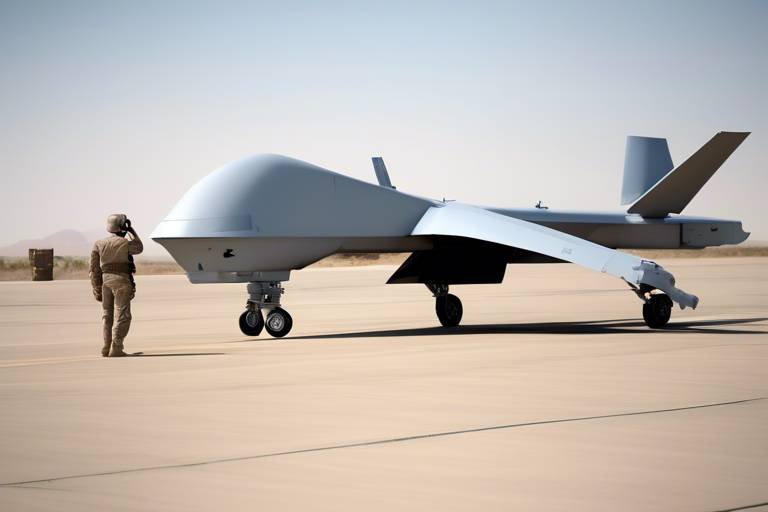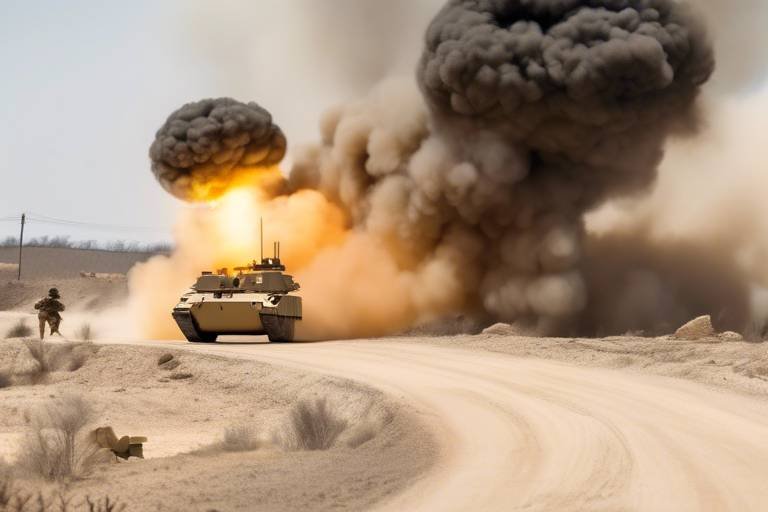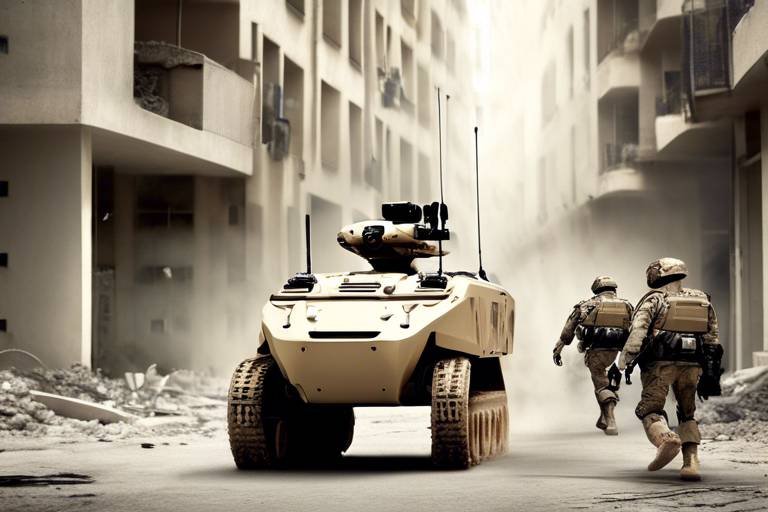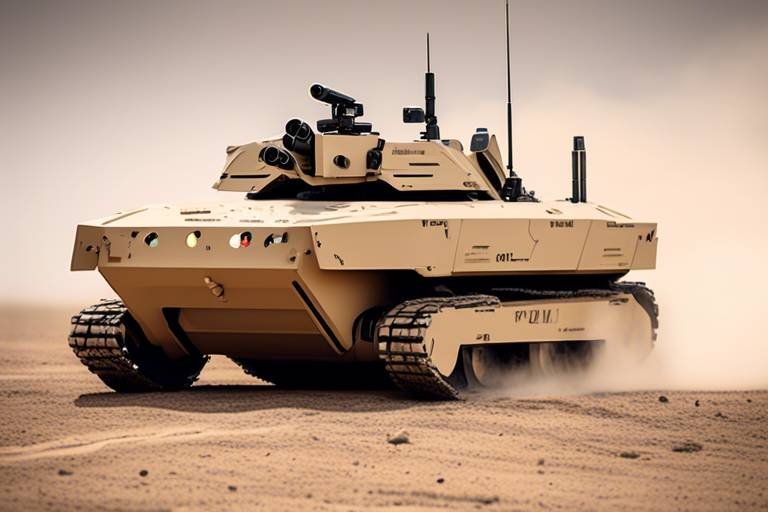Analyzing the Operational Benefits of the ZSU-23-4 in Modern Warfare
The ZSU-23-4, a self-propelled anti-aircraft gun, has made a significant mark in the realm of modern warfare. Its origins trace back to the 1960s, but its operational benefits continue to resonate in contemporary combat scenarios. In an era where air superiority is paramount, the ZSU-23-4 stands out as a versatile and effective solution for ground forces facing aerial threats. But what exactly makes this system so valuable? Let's dive deeper into its advantages, effectiveness, and relevance in today's military operations.
One of the most striking features of the ZSU-23-4 is its mobility. Unlike static air defense systems, this platform can maneuver swiftly across the battlefield, allowing it to reposition as threats emerge. Imagine it as a nimble dancer, gracefully shifting to avoid incoming fire while delivering its own. This mobility is crucial, especially in dynamic combat environments where threats can arise from any direction. Additionally, the ZSU-23-4 is equipped with a powerful radar system that enhances its target acquisition capabilities, ensuring that it can detect and engage low-flying aircraft effectively.
Moreover, the ZSU-23-4 is not just about speed and agility; it boasts a formidable armament of four 23mm autocannons. This firepower allows it to unleash a hail of rounds at enemy aircraft, effectively disrupting their operations. In a world where drones and low-flying aircraft are becoming more prevalent, the ZSU-23-4's ability to counter these threats is more relevant than ever. Its dual-role capability—serving both as a ground-based support system and an anti-aircraft platform—makes it an indispensable asset for modern military forces.
What sets the ZSU-23-4 apart from other anti-aircraft systems is its cost-effectiveness. While many contemporary systems may come with a hefty price tag and complicated maintenance requirements, the ZSU-23-4 offers a simpler, more affordable alternative without sacrificing effectiveness. This makes it an attractive option for nations looking to bolster their air defense capabilities without breaking the bank. Additionally, its relatively low logistical footprint allows for easier integration into existing military structures.
In terms of operational benefits, the ZSU-23-4 excels in providing protection for ground troops. In many conflicts, ground forces have found themselves vulnerable to air attacks, especially from helicopters and drones. The ZSU-23-4 acts as a shield, offering critical support that can turn the tide in ground engagements. Its presence can deter enemy aircraft from approaching, thus enhancing the overall safety and effectiveness of ground operations.
To illustrate the ZSU-23-4's impact, let’s consider a few key statistics:
| Feature | Specification |
|---|---|
| Caliber | 23mm |
| Rate of Fire | Up to 3,400 rounds per minute |
| Effective Range | Up to 2,500 meters |
| Radar System | Search and tracking radar |
In conclusion, the ZSU-23-4 remains a relevant and effective system in modern warfare. Its combination of mobility, firepower, cost-effectiveness, and protective capabilities makes it a valuable asset for military forces around the globe. As we continue to see advancements in military technology and the evolving nature of warfare, the ZSU-23-4's adaptability ensures that it will maintain its operational benefits for years to come.
- What is the primary role of the ZSU-23-4? The ZSU-23-4 serves primarily as an anti-aircraft platform, providing ground troops with protection against low-flying aircraft and drones.
- How does the ZSU-23-4 compare to modern air defense systems? While modern systems may offer advanced technology, the ZSU-23-4 is valued for its cost-effectiveness, simplicity, and proven reliability in combat.
- Can the ZSU-23-4 be integrated with other military systems? Yes, the ZSU-23-4 can be integrated with various military technologies, enhancing its operational capabilities on the battlefield.

Historical Background of the ZSU-23-4
The ZSU-23-4, often referred to as the "Shilka," is a self-propelled anti-aircraft gun system that first entered service in the 1960s. Developed by the Soviet Union, this formidable weapon was designed to counter the increasing threat posed by low-flying aircraft. Its inception came at a time when military strategists recognized the need for mobile air defense systems that could provide immediate support to ground forces. The ZSU-23-4 was designed to fulfill this role, combining speed, firepower, and versatility.
With a twin 23mm cannon mounted on a fully rotating turret, the ZSU-23-4 was revolutionary in its ability to engage aerial targets effectively. The system was equipped with a radar unit that allowed for target acquisition and tracking, which was essential for engaging fast-moving aircraft. Its design philosophy was rooted in the necessity for a system that could be deployed quickly and could adapt to the rapidly changing dynamics of battlefield conditions.
Throughout the decades, the ZSU-23-4 has been a critical component of various military arsenals around the world. Its operational history spans numerous conflicts, demonstrating its robustness and reliability. The system was not only utilized by the Soviet Union but also exported to many allied nations, where it saw action in diverse combat scenarios. This widespread deployment has led to various modifications and adaptations, reflecting the evolving nature of warfare and technological advancements.
One of the key features of the ZSU-23-4 is its ability to engage multiple targets simultaneously. With a rate of fire that can exceed 1,000 rounds per minute, it can unleash a hail of fire against enemy aircraft, making it a significant deterrent in the skies. The combination of its high velocity, effective range, and rapid target acquisition capabilities solidified its reputation as a reliable air defense system.
As military needs have changed, the ZSU-23-4 has undergone various upgrades to enhance its performance. Modernized versions have incorporated advanced radar systems, improved ammunition types, and better mobility features. This evolution has allowed the ZSU-23-4 to maintain its relevance in contemporary military operations, proving that even legacy systems can adapt to modern warfare challenges.
In summary, the historical background of the ZSU-23-4 reveals a system that was born out of necessity and has continually adapted to the changing landscape of military operations. Its blend of firepower, mobility, and adaptability has made it a stalwart in air defense, showcasing the importance of innovation in military technology.
- What is the primary function of the ZSU-23-4? The ZSU-23-4 serves primarily as an anti-aircraft weapon system designed to protect ground troops from low-flying aircraft.
- When was the ZSU-23-4 first introduced? The ZSU-23-4 was first introduced in the 1960s, during the Cold War era.
- How effective is the ZSU-23-4 against modern aircraft? While the ZSU-23-4 was highly effective in its time, its effectiveness against modern stealth aircraft is limited. However, upgrades have enhanced its capabilities.
- Is the ZSU-23-4 still in use today? Yes, many countries still operate the ZSU-23-4, often in upgraded forms, due to its reliability and effectiveness in certain combat scenarios.

Technical Specifications
The ZSU-23-4, a formidable anti-aircraft artillery system, boasts a range of impressive technical specifications that underline its effectiveness in modern warfare. Developed in the 1960s, this self-propelled weapon system is equipped with a quartet of 23mm autocannons, which are capable of delivering a rapid rate of fire. Specifically, the ZSU-23-4 can unleash up to 3,400 rounds per minute, making it a lethal force against low-flying aircraft and other aerial threats. Its design allows for a high degree of maneuverability, enabling it to be deployed quickly in various combat scenarios.
One of the standout features of the ZSU-23-4 is its integrated radar system. The radar not only facilitates target acquisition but also enhances tracking capabilities, allowing the operators to engage multiple targets simultaneously. This is crucial during engagements where enemy aircraft may attempt to evade detection through low-altitude flight. The radar system operates effectively in diverse weather conditions, ensuring that the ZSU-23-4 remains operational even in less than ideal scenarios.
To give you a clearer picture of its capabilities, here’s a table summarizing the key technical specifications of the ZSU-23-4:
| Specification | Details |
|---|---|
| Armament | Four 23mm autocannons |
| Rate of Fire | Up to 3,400 rounds per minute |
| Effective Range | Up to 2,500 meters |
| Radar System | Search and tracking radar |
| Mobility | Self-propelled on a tracked chassis |
| Weight | Approximately 20 tons |
Moreover, the ZSU-23-4 features a robust chassis that allows it to traverse various terrains, making it an agile asset on the battlefield. Its self-propelled design means that it can quickly reposition in response to threats, providing a crucial advantage in fast-paced combat situations. With its ability to engage targets at a range of up to 2,500 meters, the ZSU-23-4 stands as a reliable guardian against aerial incursions.
In terms of operational efficiency, the ZSU-23-4 also benefits from a relatively low logistical footprint, allowing for easier maintenance and deployment in the field. This is particularly advantageous for military forces that need to maintain a high level of readiness without overextending their resources. The combination of firepower, mobility, and radar capabilities makes the ZSU-23-4 a significant player in the realm of air defense.
- What is the primary purpose of the ZSU-23-4?
The ZSU-23-4 is primarily designed for air defense, specifically to engage low-flying aircraft and protect ground forces. - How does the radar system enhance the ZSU-23-4's capabilities?
The integrated radar system allows for effective target acquisition and tracking, enabling the ZSU-23-4 to engage multiple targets simultaneously. - What are the advantages of its self-propelled design?
The self-propelled design provides mobility and quick repositioning, essential for adapting to fast-changing combat scenarios.

Role in Air Defense
The ZSU-23-4, often referred to as the "Shilka," has carved out a significant niche for itself in the realm of air defense. With its impressive combination of mobility, firepower, and radar systems, it serves as a formidable barrier against aerial threats. Imagine it as a vigilant guardian, constantly scanning the skies for any signs of danger. This self-propelled anti-aircraft gun system is particularly adept at targeting low-flying aircraft, making it a crucial asset for ground troops who often find themselves vulnerable to air assaults.
One of the standout features of the ZSU-23-4 is its dual role as both a mobile platform and a defensive weapon. The ability to quickly reposition on the battlefield allows for rapid response to changing threats, ensuring that it can provide immediate air cover when needed. Think of it as a Swiss Army knife in military operations—versatile and ready for action at a moment's notice. The combination of four 23mm autocannons provides a high rate of fire, capable of unleashing a barrage of rounds that can saturate an area, effectively deterring enemy aircraft from approaching.
Moreover, the ZSU-23-4 is equipped with advanced radar systems that enhance its situational awareness. These systems allow the Shilka to detect and track multiple targets simultaneously, giving it an edge in fast-paced combat scenarios. The radar not only aids in targeting but also in assessing the threat level of incoming aircraft, allowing operators to make informed decisions quickly. This capability is essential in modern warfare, where the speed of engagement can determine the outcome of a battle.
In addition to its technical prowess, the ZSU-23-4's role in air defense is further amplified by its integration with ground forces. As part of a layered defense strategy, it works in conjunction with other anti-aircraft systems, creating a comprehensive shield against aerial threats. For instance, while long-range missile systems may engage high-altitude threats, the ZSU-23-4 focuses on those pesky low-flying aircraft that could be targeting ground troops or critical infrastructure. This collaborative approach ensures that all potential angles of attack are covered, significantly enhancing the overall effectiveness of air defense operations.
However, it's important to note that while the ZSU-23-4 is a powerful asset, it is not without its vulnerabilities. As air defense systems evolve, the Shilka faces challenges from advanced aircraft and precision-guided munitions. To remain relevant, continual upgrades and adaptations are necessary. This is where discussions around modernization come into play, ensuring that the ZSU-23-4 can compete with newer technologies and maintain its critical role in air defense.
In summary, the ZSU-23-4 stands as a testament to the importance of air defense in modern warfare. Its ability to engage low-flying threats, combined with its mobility and integration with ground forces, makes it an invaluable component of military operations. As we look to the future, the ongoing development and enhancement of the ZSU-23-4 will be crucial in addressing the evolving challenges of aerial warfare.
- What is the primary function of the ZSU-23-4? The primary function of the ZSU-23-4 is to provide air defense against low-flying aircraft, protecting ground troops and critical assets.
- How does the ZSU-23-4 detect airborne threats? It employs radar systems that allow it to detect and track multiple aerial targets, ensuring effective engagement.
- Can the ZSU-23-4 be integrated with other military systems? Yes, it is designed to work in conjunction with other air defense systems, creating a layered defense strategy.
- What are the limitations of the ZSU-23-4? While effective, it faces challenges from advanced aircraft and precision-guided munitions, necessitating upgrades to keep pace with modern threats.

Combat Effectiveness
The ZSU-23-4 has proven itself as a formidable anti-aircraft platform in various combat scenarios, demonstrating its reliability and adaptability on the battlefield. Originally designed in the 1960s, this self-propelled anti-aircraft gun has undergone numerous evaluations that highlight its combat effectiveness. What makes it stand out? Its unique combination of mobility, firepower, and radar capabilities allows it to engage a wide range of aerial threats, from low-flying aircraft to drones, making it a valuable asset in modern warfare.
One of the key factors contributing to the ZSU-23-4's combat effectiveness is its rapid-fire 23mm cannons. These guns are capable of firing up to 2,500 rounds per minute, providing a high volume of fire that can saturate an area and increase the likelihood of hitting fast-moving targets. This is particularly crucial in today’s combat environment, where aerial threats can appear suddenly and require immediate response. Additionally, the ZSU-23-4's radar system enables it to detect and track multiple targets simultaneously, allowing for coordinated fire against incoming threats.
In terms of operational flexibility, the ZSU-23-4 can be deployed in various environments, from open fields to urban settings. Its mobility is enhanced by a robust chassis, allowing it to reposition quickly in response to changing battlefield conditions. This agility not only helps it evade enemy fire but also allows it to provide timely support to ground troops under aerial attack. Imagine a scene where ground forces are under heavy air assault; the ZSU-23-4 can maneuver into position and unleash a torrent of fire, turning the tide of battle.
Moreover, the ZSU-23-4 has been successfully integrated into combined arms operations, where its capabilities complement those of other military assets. For instance, when paired with advanced surveillance systems, it can enhance situational awareness and target acquisition, allowing for precise engagement of enemy aircraft. This synergy between systems is what makes the ZSU-23-4 not just a standalone weapon but a critical component of a modern air defense strategy.
To illustrate its effectiveness, let’s look at some notable examples of the ZSU-23-4 in action:
| Conflict | Year | Outcome |
|---|---|---|
| Yom Kippur War | 1973 | Effective against Israeli aircraft |
| Gulf War | 1991 | Limited effectiveness due to advanced enemy technology |
| Syrian Civil War | 2011-Present | Continued use against rebel aircraft and drones |
As demonstrated in these conflicts, the ZSU-23-4 has had varying degrees of success, influenced by factors such as the technological advancements of opposing forces and the tactical situation on the ground. While it faced challenges during the Gulf War due to the overwhelming technological superiority of coalition forces, its performance in the Yom Kippur War and ongoing conflicts in Syria showcases its enduring relevance.
In conclusion, the ZSU-23-4 remains a potent force in air defense, capable of adapting to the evolving landscape of modern warfare. Its combination of firepower, mobility, and integration with other military systems ensures that it will continue to play a significant role in protecting ground troops from aerial threats. As military strategies evolve, the ZSU-23-4's combat effectiveness is likely to be tested and refined, ensuring its place in the arsenals of modern armies.
- What is the primary function of the ZSU-23-4?
The ZSU-23-4 is primarily designed as an anti-aircraft platform to protect ground forces from aerial threats. - How effective is the ZSU-23-4 against modern drones?
While it was originally designed for manned aircraft, the ZSU-23-4 has shown effectiveness against drones, especially in environments where they fly at low altitudes. - Can the ZSU-23-4 be upgraded?
Yes, the ZSU-23-4 can be upgraded with modern targeting systems and additional fire control technologies to enhance its combat effectiveness.

Integration with Modern Systems
As warfare evolves, so does the need for military systems to adapt and integrate with modern technologies. The ZSU-23-4, originally designed in the 1960s, has proven to be a resilient and effective anti-aircraft platform. However, to maintain its relevance, it must be integrated with contemporary systems that enhance its operational capabilities. This integration is not just about adding new technologies; it's about creating a synergistic relationship between legacy systems and cutting-edge innovations.
One of the most significant areas of integration involves network-centric warfare. By connecting the ZSU-23-4 to modern command and control systems, operators can receive real-time data from various sources, including satellites, drones, and other air defense units. This connectivity allows for a more coordinated response to aerial threats, enabling the ZSU-23-4 to engage targets more effectively. For instance, when linked with advanced radar systems, the ZSU-23-4 can quickly identify and track low-flying aircraft, enhancing its defensive capabilities.
Moreover, the integration of modern targeting systems can significantly improve the accuracy of the ZSU-23-4. By utilizing laser-guided munitions and advanced fire control systems, the platform can engage targets with greater precision, reducing the risk of collateral damage. This capability is crucial in today's combat environment, where minimizing civilian casualties is paramount. The combination of traditional artillery fire with modern targeting technology creates a formidable defense mechanism that can adapt to various threats.
Another key aspect of modern integration is the incorporation of unmanned aerial vehicles (UAVs) into the operational framework. UAVs can be deployed for reconnaissance, providing valuable intelligence about enemy movements and potential threats. When integrated with the ZSU-23-4, these drones can relay targeting information directly to the operators, allowing for a quick and efficient response to aerial incursions. This relationship not only enhances the ZSU-23-4's effectiveness but also extends its operational range and situational awareness.
Furthermore, the potential for software upgrades cannot be overlooked. As technology progresses, updating the ZSU-23-4 with the latest software can improve its operational capabilities without the need for extensive hardware changes. These upgrades can include enhanced tracking algorithms, improved user interfaces, and advanced threat analysis tools that keep the system competitive against newer technologies.
In terms of logistics and maintenance, integrating modern diagnostic tools can streamline the upkeep of the ZSU-23-4. Utilizing predictive maintenance technologies, military personnel can monitor the health of the system in real-time, ensuring that it remains combat-ready. This proactive approach not only reduces downtime but also extends the lifespan of the equipment.
In conclusion, the integration of the ZSU-23-4 with modern systems is not merely an enhancement; it is a necessity in the face of evolving threats in contemporary warfare. By embracing network-centric capabilities, advanced targeting systems, UAVs, and software upgrades, the ZSU-23-4 can continue to serve as a vital asset on the battlefield. As military strategies evolve, so too must the tools that support them, ensuring that legacy systems like the ZSU-23-4 remain relevant and effective.
- What is the ZSU-23-4? The ZSU-23-4 is a self-propelled anti-aircraft gun system developed in the 1960s, primarily designed to engage low-flying aircraft.
- How does the ZSU-23-4 integrate with modern systems? It can be integrated with modern command and control systems, UAVs, and advanced targeting technologies to enhance its effectiveness.
- What are the benefits of integrating UAVs with the ZSU-23-4? UAVs provide real-time reconnaissance and targeting information, improving the ZSU-23-4's situational awareness and response time to threats.
- Can the ZSU-23-4 be upgraded with new software? Yes, software upgrades can enhance its operational capabilities without extensive hardware changes, keeping it competitive.

Case Studies of Deployment
The ZSU-23-4, with its robust design and versatile capabilities, has been deployed in various conflicts around the world, showcasing its effectiveness in real combat scenarios. One of the most notable instances occurred during the Yom Kippur War in 1973, where the ZSU-23-4 was instrumental in providing air defense for ground forces against Israeli air strikes. Its ability to engage low-flying aircraft made it a formidable opponent, and many ground troops relied on its cover to navigate the battlefield safely. The operational success seen in this conflict highlighted the ZSU-23-4's integration into air defense strategies, proving that even older systems could hold their ground against modern threats.
Another significant deployment took place during the Gulf War in 1991. Although the ZSU-23-4 faced challenges from advanced coalition aircraft, its presence on the battlefield was still felt. Iraqi forces utilized the system to protect critical infrastructure, such as command centers and supply lines. Despite being outmatched technologically, the ZSU-23-4's rapid-fire capabilities allowed it to engage multiple aerial threats effectively. This case study emphasizes the importance of adapting tactics and understanding the limitations of legacy systems in modern warfare.
In more recent conflicts, such as the Syrian Civil War, the ZSU-23-4 has continued to be a relevant asset. Various factions have employed it to defend against airstrikes and drones, demonstrating its adaptability in the face of evolving threats. The system's mobility allows it to be repositioned quickly, providing flexible air defense solutions in dynamic combat environments. The ongoing use of the ZSU-23-4 in Syria underscores its enduring legacy and the necessity for military planners to consider such platforms in their strategic assessments.
To further illustrate the ZSU-23-4's deployment history, the following table summarizes key case studies:
| Conflict | Year | Role | Outcome |
|---|---|---|---|
| Yom Kippur War | 1973 | Air defense for ground troops | Effective against Israeli air strikes |
| Gulf War | 1991 | Protection of infrastructure | Faced advanced coalition aircraft |
| Syrian Civil War | 2011-Present | Defense against airstrikes and drones | Continues to be used by various factions |
These case studies not only highlight the ZSU-23-4's operational effectiveness but also illustrate the importance of adapting to the changing landscape of warfare. As military technology evolves, the lessons learned from these deployments can inform future strategies and enhance the capabilities of both legacy and modern systems. The ZSU-23-4 may be an older platform, but its deployment history proves that it still has a role to play in contemporary military operations.
- What is the ZSU-23-4? The ZSU-23-4 is a self-propelled anti-aircraft gun system designed to provide air defense against low-flying aircraft.
- When was the ZSU-23-4 first introduced? The ZSU-23-4 was introduced in the early 1960s and has seen various upgrades over the years.
- What are the primary advantages of the ZSU-23-4? Its primary advantages include rapid-fire capabilities, mobility, and effectiveness against low-flying threats.
- Where has the ZSU-23-4 been deployed? The ZSU-23-4 has been deployed in numerous conflicts, including the Yom Kippur War, the Gulf War, and the Syrian Civil War.
- Can the ZSU-23-4 be integrated with modern systems? Yes, the ZSU-23-4 can be integrated with modern military technologies to enhance its operational capabilities.

Comparative Analysis with Other Systems
The ZSU-23-4, often seen as a stalwart of air defense, holds a unique position when compared to other anti-aircraft systems in modern warfare. While it may not boast the advanced technology of newer systems, its design and operational capabilities have proven their worth on numerous occasions. To truly appreciate the ZSU-23-4, we must delve into its strengths and weaknesses in relation to contemporary alternatives.
When we pit the ZSU-23-4 against systems like the Stinger missile or the more advanced Patriot missile system, several key differences emerge. The ZSU-23-4 is a self-propelled anti-aircraft gun that combines a rapid-fire capability with radar guidance, making it effective against low-flying aircraft. In contrast, systems like the Stinger are shoulder-fired, man-portable missiles that provide flexibility but lack the sustained firepower of the ZSU-23-4. This means that while the Stinger excels in mobility and ease of use, the ZSU-23-4 can engage multiple targets in a shorter time frame, providing a different tactical advantage.
Moreover, the ZSU-23-4's radar system allows it to track and engage targets effectively, which is a significant advantage in chaotic combat environments. However, its reliance on radar also makes it vulnerable to electronic warfare tactics that can disrupt its targeting capabilities. In contrast, systems like the NASAMS (National Advanced Surface-to-Air Missile System) utilize a combination of radar and advanced missile technology to provide a more resilient defense against sophisticated aerial threats.
To illustrate these comparisons further, here’s a concise table highlighting some of the key specifications and operational characteristics of the ZSU-23-4 and its competitors:
| System | Type | Range (km) | Max Altitude (m) | Fire Rate (rounds/min) |
|---|---|---|---|---|
| ZSU-23-4 | Self-Propelled Anti-Aircraft Gun | 2.5 - 4 | 2000 | 200 |
| Stinger Missile | Man-Portable Air Defense System | 5 | 3500 | N/A |
| NASAMS | Medium-Range Air Defense System | 25 | 9000 | N/A |
As we can see from the table, the ZSU-23-4 offers a high rate of fire, which can be decisive in engaging swarms of low-flying threats. However, its range and altitude capabilities are limited compared to systems like NASAMS. This brings us to the question of operational context: in scenarios where ground troops face immediate aerial threats, the ZSU-23-4 can be a game-changer. Yet, in environments where longer-range engagement is necessary, more advanced systems may be preferred.
Furthermore, the ZSU-23-4’s legacy and widespread use in various militaries around the world cannot be overlooked. Its simplicity and reliability make it an attractive option for nations looking to bolster their air defense without the need for extensive training or complex logistics. In many cases, the decision to deploy the ZSU-23-4 comes down to cost-effectiveness and the specific threats faced by a military.
In conclusion, while the ZSU-23-4 may not be the most advanced anti-aircraft system available today, its unique attributes allow it to maintain relevance in the modern battlefield. Understanding its strengths and weaknesses in comparison to other systems is crucial for military strategists as they navigate the complexities of contemporary warfare.
- What are the primary advantages of the ZSU-23-4? The ZSU-23-4 offers a high rate of fire and effective engagement of low-flying aircraft, making it valuable for ground troop protection.
- How does the ZSU-23-4 compare in terms of cost? The ZSU-23-4 is generally more cost-effective compared to more advanced systems like NASAMS, making it accessible for many nations.
- Can the ZSU-23-4 be upgraded? Yes, there are various upgrade options available that can enhance its radar and targeting systems to improve its effectiveness.

Future Prospects and Upgrades
The ZSU-23-4, despite being a legacy system introduced in the 1960s, still holds a significant place in modern military arsenals. However, as warfare evolves, so too must the capabilities of this anti-aircraft platform. The future prospects for the ZSU-23-4 hinge on several potential upgrades that can enhance its operational effectiveness in contemporary combat scenarios. For instance, integrating advanced radar systems could substantially improve target acquisition and tracking, allowing it to engage more sophisticated aerial threats that have emerged in recent years.
One of the most exciting avenues for the ZSU-23-4's future is the incorporation of modern fire control systems. These systems can provide real-time data analysis and target prioritization, making the ZSU-23-4 not just a static defense unit but a dynamic component of a larger air defense network. Imagine a scenario where the ZSU-23-4 communicates seamlessly with drones and other surveillance assets, sharing information and coordinating strikes against incoming threats. This level of integration could transform the ZSU-23-4 into a formidable player on the battlefield.
Moreover, the possibility of retrofitting the ZSU-23-4 with modern munitions cannot be overlooked. Advanced ammunition types, such as guided projectiles, can significantly increase hit probability and lethality against fast-moving targets. This upgrade would not only enhance the ZSU-23-4’s effectiveness but also extend its operational lifespan, allowing it to remain relevant in a rapidly changing military landscape.
In addition to technological upgrades, there is also a need for comprehensive training programs for personnel operating the ZSU-23-4. As newer systems are introduced into the military, it's crucial that operators are well-versed in both the traditional capabilities of the ZSU-23-4 and the new technologies being integrated. This dual knowledge will ensure that the ZSU-23-4 can be deployed effectively alongside modern systems, maximizing its potential.
Ultimately, the future of the ZSU-23-4 relies on a balanced approach that combines technological upgrades with effective training and integration into modern military frameworks. As military strategists continue to assess the evolving nature of aerial threats, the ZSU-23-4 can remain a key asset, provided it adapts to the changing dynamics of warfare. The investment in these upgrades is not merely about preserving a piece of military history; it’s about ensuring that the ZSU-23-4 continues to play a vital role in safeguarding ground forces against aerial assaults.
- What are the main upgrades proposed for the ZSU-23-4? Potential upgrades include modern radar systems, advanced fire control systems, and guided munitions.
- How does the ZSU-23-4 compare to newer anti-aircraft systems? While it may lack some modern features, its adaptability and potential for upgrades keep it relevant in many situations.
- Can the ZSU-23-4 be effectively integrated with modern military technology? Yes, with the right upgrades and training, it can operate alongside newer systems, enhancing its effectiveness.
- What role does training play in the effectiveness of the ZSU-23-4? Comprehensive training ensures operators are proficient in both traditional and modern capabilities, maximizing the system's potential.
Frequently Asked Questions
- What is the ZSU-23-4?
The ZSU-23-4 is a self-propelled anti-aircraft gun system developed in the Soviet Union, primarily designed to engage low-flying aircraft. It features a quad-barrel 23mm cannon, which allows for a high rate of fire, making it effective against various aerial threats.
- How does the ZSU-23-4 compare to modern air defense systems?
While the ZSU-23-4 may lack some advanced technologies found in modern air defense systems, it offers unique advantages such as mobility and a rapid response capability. Its effectiveness in specific combat scenarios can still make it a valuable asset alongside newer systems.
- What are the key technical specifications of the ZSU-23-4?
The ZSU-23-4 boasts a range of technical specifications, including:
- Armament: Four 23mm autocannons
- Radar: A fire control radar system for target tracking
- Mobility: Wheeled chassis allowing for rapid deployment
- In what conflicts has the ZSU-23-4 been used?
The ZSU-23-4 has seen action in numerous conflicts since its introduction, including the Vietnam War, the Gulf War, and various regional conflicts. Its deployment in these scenarios highlights its adaptability and effectiveness in different combat situations.
- Can the ZSU-23-4 be upgraded?
Yes, the ZSU-23-4 can be upgraded with modern technologies, such as enhanced radar systems and improved targeting capabilities. These upgrades can significantly boost its effectiveness and ensure its relevance in contemporary warfare.
- What is the role of the ZSU-23-4 in air defense?
The ZSU-23-4 plays a crucial role in air defense by providing ground troops with essential protection against low-flying aircraft. Its quick reaction time and high rate of fire make it an effective deterrent against aerial threats.
- How has the ZSU-23-4 been integrated with modern military systems?
The ZSU-23-4 can be integrated with modern military systems by linking it to advanced command and control systems, allowing for better coordination and effectiveness on the battlefield. This integration enhances its operational capabilities in contemporary combat scenarios.
- What are the strengths and weaknesses of the ZSU-23-4?
Some strengths of the ZSU-23-4 include:
- High rate of fire
- Mobility
- Cost-effectiveness
However, its weaknesses may include:
- Limited range compared to missile systems
- Vulnerability to advanced air threats



















